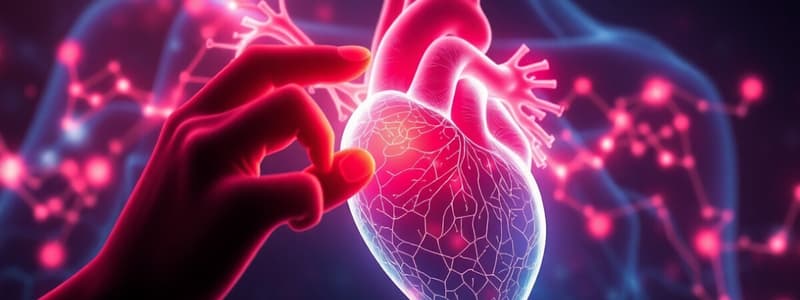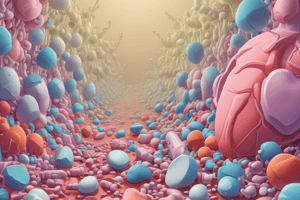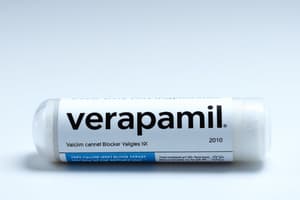Podcast
Questions and Answers
What is the primary therapeutic use of verapamil?
What is the primary therapeutic use of verapamil?
- Management of headaches
- Prevention of ventricular tachycardia
- Reduction of facial flushing
- Treatment of vasospastic angina (correct)
What is the most common adverse effect associated with verapamil?
What is the most common adverse effect associated with verapamil?
- Ankle edema
- Headache
- Constipation (correct)
- Dizziness
Which interaction can lead to an increased risk of toxicity when taking verapamil?
Which interaction can lead to an increased risk of toxicity when taking verapamil?
- Use of diuretics
- Administration of nitrates
- Consumption of grapefruit juice (correct)
- Interaction with aspirin
What complication can arise from intravenous verapamil administration for dysrhythmias?
What complication can arise from intravenous verapamil administration for dysrhythmias?
Which of the following conditions is NOT listed as a therapeutic use for verapamil?
Which of the following conditions is NOT listed as a therapeutic use for verapamil?
What is a common therapeutic use of calcium channel blockers like verapamil and diltiazem?
What is a common therapeutic use of calcium channel blockers like verapamil and diltiazem?
Which adverse effect is associated with the use of calcium channel blockers?
Which adverse effect is associated with the use of calcium channel blockers?
Combining amiodarone with which type of medication can potentially slow the heart rate excessively?
Combining amiodarone with which type of medication can potentially slow the heart rate excessively?
What physiological effect do calcium channel blockers have on the SA node?
What physiological effect do calcium channel blockers have on the SA node?
Which of the following is NOT a risk associated with diuretics?
Which of the following is NOT a risk associated with diuretics?
What is the primary stimulus for the activation of the renin-angiotensin-aldosterone system (RAAS) in heart failure?
What is the primary stimulus for the activation of the renin-angiotensin-aldosterone system (RAAS) in heart failure?
In which type of heart failure is the ejection fraction typically reduced to less than 40%?
In which type of heart failure is the ejection fraction typically reduced to less than 40%?
Which condition is primarily caused by right-sided heart failure?
Which condition is primarily caused by right-sided heart failure?
What is one of the main effects of left-sided heart failure?
What is one of the main effects of left-sided heart failure?
Which symptom is commonly associated with pulmonary edema in heart failure?
Which symptom is commonly associated with pulmonary edema in heart failure?
Which of the following best describes diastolic heart failure?
Which of the following best describes diastolic heart failure?
What effect does heart failure have on the lungs?
What effect does heart failure have on the lungs?
What typically causes congenital heart defects in children?
What typically causes congenital heart defects in children?
Which structure allows blood to bypass the liver in fetal circulation?
Which structure allows blood to bypass the liver in fetal circulation?
What condition results in deoxygenated blood being shunted to the body?
What condition results in deoxygenated blood being shunted to the body?
Which defect may present with bounding pulses and high blood pressure in the upper body?
Which defect may present with bounding pulses and high blood pressure in the upper body?
What is the primary treatment method for symptomatic patent ductus arteriosus?
What is the primary treatment method for symptomatic patent ductus arteriosus?
In fetal circulation, what does the foramen ovale primarily help to accomplish?
In fetal circulation, what does the foramen ovale primarily help to accomplish?
What is a common symptom of ventricular septal defects in infants?
What is a common symptom of ventricular septal defects in infants?
Which of the following is a characteristic of the Tetralogy of Fallot?
Which of the following is a characteristic of the Tetralogy of Fallot?
What condition requires shunting for survival, often due to transposition of the great arteries?
What condition requires shunting for survival, often due to transposition of the great arteries?
What is the primary rationale for surgical treatment of Coarctation of the Aorta?
What is the primary rationale for surgical treatment of Coarctation of the Aorta?
What leads to pulmonary vascular disease after 20 years if left untreated?
What leads to pulmonary vascular disease after 20 years if left untreated?
What pathway leads from genetic predisposition to type 2 diabetes through the liver?
What pathway leads from genetic predisposition to type 2 diabetes through the liver?
Which of the following is a clinical manifestation primarily due to hyperglycemia in diabetes?
Which of the following is a clinical manifestation primarily due to hyperglycemia in diabetes?
In the context of metabolic syndrome, which obesity shape is more strongly linked to metabolic and cardiovascular risks?
In the context of metabolic syndrome, which obesity shape is more strongly linked to metabolic and cardiovascular risks?
What condition is more likely to occur in type 2 diabetes as a result of stress and lack of insulin?
What condition is more likely to occur in type 2 diabetes as a result of stress and lack of insulin?
What is the primary treatment for diabetic ketoacidosis?
What is the primary treatment for diabetic ketoacidosis?
What condition is associated with the Somogyi effect?
What condition is associated with the Somogyi effect?
Which neurological manifestations can occur due to a hyperglycemic hyperosmolar state?
Which neurological manifestations can occur due to a hyperglycemic hyperosmolar state?
Which of these factors is NOT considered a major component of metabolic syndrome?
Which of these factors is NOT considered a major component of metabolic syndrome?
What is the typical resolution of gestational diabetes following delivery?
What is the typical resolution of gestational diabetes following delivery?
What does hypoglycemia generally indicate when blood sugar levels fall below 70 mg/dL?
What does hypoglycemia generally indicate when blood sugar levels fall below 70 mg/dL?
Study Notes
Verapamil
- Verapamil and diltiazem have little to no net effects on cardiac performance.
- It causes vasodilation, resulting in reduced arterial pressure and increased coronary perfusion.
- Therapeutic uses include angina pectoris, essential hypertension, cardiac dysrhythmias, and migraines.
- Common adverse effects include constipation, dizziness, facial flushing, headache, edema, gingival hyperplasia, and heart blocks.
- Grapefruit juice can increase verapamil levels, potentially leading to toxicity.
- Drug interactions are possible with digoxin and beta-adrenergic blocking agents.
- Toxicity is characterized by severe hypotension, bradycardia, AV block, and ventricular tachydysrhythmia.
- IV verapamil, used for dysrhythmias, can cause severe cardiovascular effects, requiring close monitoring of blood pressure and ECG.
Compensatory Mechanisms in Heart Failure
- Mechanisms focus on maintaining cardiac output (CO).
- Decreased cardiac output leads to decreased renal blood flow, which stimulates the renin-angiotensin-aldosterone system (RAAS) to retain fluid.
- The sympathetic nervous system is also stimulated to increase heart rate and peripheral vascular resistance (PVR), further increasing CO.
- Increased ventricular pressure results in increased blood backup, myocardial stretch, and oxygen consumption, ultimately worsening heart failure.
Types of Heart Failure
- Heart failure can be classified as systolic or diastolic.
- Systolic failure is characterized by a reduced ejection fraction (<40%) due to decreased myocardial contractility.
- Diastolic failure occurs when ejection fraction is normal, but myocardial relaxation is impaired, resulting in decreased filling volumes.
- Heart failure can also be categorized as right-sided or left-sided.
- Right-sided failure involves blood backup from the right ventricle into the periphery, leading to edema.
- Left-sided failure involves blood backup from the left ventricle into the lungs, causing pulmonary congestion.
Right-Sided Heart Failure
- Diastolic right-sided heart failure occurs when the right ventricle (RV) cannot accept enough blood from the body.
- Systolic right-sided heart failure occurs when the RV cannot pump enough blood to the lungs.
- Impaired pump function leads to blood backup from the right heart to the body, eventually affecting the left heart and lungs.
- Edema develops as fluid accumulates in the body, and the lungs struggle to oxygenate blood.
Left-Sided Heart Failure
- Diastolic left-sided heart failure occurs when the left ventricle (LV) cannot accept enough blood from the lungs.
- Systolic left-sided heart failure occurs when the LV cannot pump enough blood to the body.
- Impaired pump function in the left heart leads to blood backup into the lungs, eventually affecting the right heart and body.
- Fluid accumulates in the lungs, compromising oxygenation of the blood.
Pulmonary Edema Due to Heart Failure
- Fluid from capillaries moves into the alveoli, making the lungs stiffer and harder to inhale.
- Gas exchange is impaired, leading to crackles on auscultation and frothy pink sputum in severe cases.
- Hemoglobin is not fully oxygenated, resulting in hypoxia.
Heart Disease and Children
- Congenital heart defects are often attributed to genetic and environmental factors.
- Proper prenatal care is crucial to prevent defects linked to maternal disorders and teratogenic drugs.
- Clinical manifestations typically relate to blood shunting, cyanosis, and disruptions in pulmonary blood flow.
- Shunting refers to blood diversion from atrial to ventricular or ventricular to atrial circulations.
- Cyanotic defects involve deoxygenated blood circulation, while acyanotic defects do not.
- Defects can either decrease or increase pulmonary blood flow.
Shunts
- Shunts are openings or connections that allow blood to move from one side of the circulation to the other.
- Most shunts occur in the heart, moving blood either from left to right or right to left.
- Left-to-right shunts are more common due to the stronger left side of the heart.
- Shunts are normal during fetal circulation:
- Ductus venosus allows blood flow from visceral veins to the vena cava, bypassing the liver.
- Foramen ovale allows blood flow from the right atrium to the left atrium, bypassing the lungs.
- Ductus arteriosus permits blood flow from the pulmonary trunk to the aorta, bypassing the lungs.
Foramen Ovale
- Left-to-right shunts result in less blood to the body and more blood to the lungs.
- Right-to-left shunts lead to deoxygenated blood in the body and less blood in the lungs.
Congenital Heart Defects
- Patent ductus arteriosus occurs when the ductus arteriosus remains open after birth.
- The size of the ductus determines the severity of manifestations, with blood typically flowing from left to right due to pressure differences.
- Manifestations include a heart murmur.
- If left untreated, long-term consequences can arise.
- Echocardiogram is used for diagnosis, and treatment includes NSAIDs or surgery.
Septal Defects
- Septal defects represent persistent openings between heart chambers.
- Atrial septal defects can be asymptomatic, but often involve shunting of blood to the pulmonary system, increasing the risk of pulmonary vascular disease.
- Ventricular septal defects can vary in size, with larger defects causing more significant manifestations.
- Left-to-right shunting can present with tachypnea and diaphoresis during feeding.
- Echocardiograms are used for diagnosis, and treatment depends on defect size, ranging from observation to interventional procedures.
Tetralogy of Fallot
- Accounts for 5-7% of cyanotic congenital defects.
- It consists of four defects:
- Ventricular septal defect.
- Shifting of the aorta to the right.
- Narrowed pulmonary outflow.
- Right ventricular hypertrophy.
- Cyanosis results from restricted blood flow to the lungs.
- Hypercyanosis during crying and feeding may occur.
- Surgical revision is necessary.
Transposition of the Great Arteries
- The aorta originates from the right ventricle, while the pulmonary artery arises from the left ventricle.
- Shunting is essential for survival, often occurring through patent ductus arteriosus or septal defects.
- Cyanosis is a common manifestation.
- Surgery is required to realign the arteries.
Coarctation of the Aorta
- Localized narrowing of the aorta.
- Manifestations include differing pulses and blood pressure:
- Bounding pulses and high pressure in arms and carotid arteries.
- Weak pulses and low pressure in femoral, popliteal, and dorsalis arteries.
- Diagnosis is made through blood pressure measurement.
- Untreated moderate coarctation leads to left ventricular hypertrophy.
- Severe cases can cause heart failure in infants.
- Surgical treatment is necessary.
Functional Single-Ventricle Anatomy
- Hypo-plastic left heart syndrome involves a single functioning ventricle responsible for both systemic and pulmonary circulation.
- Manifestations include cyanosis.
- Surgical repair redirects systemic circulation to the pulmonary system, utilizing the single ventricle for oxygenated blood delivery.
- Heart transplantation is an option.
Pharmacology for Heart Failure and Atherosclerosis
- For detailed information, refer to the medication sheets developed for Module 5.
Class IV: Calcium Channel Blockers
- Verapamil and Diltiazem:
- Effects on the heart include:
- Reduced SA nodal automaticity.
- Delayed AV nodal conduction.
- Reduced myocardial contractility.
- Therapeutic uses:
- Slowing ventricular rate (atrial fibrillation or atrial flutter).
- Terminating supraventricular tachycardia (SVT) caused by an AV nodal reentrant circuit.
- Adverse effects:
- Bradycardia.
- Hypotension.
- AV block.
- Heart failure.
- Peripheral edema.
- Constipation.
- Drug interactions:
- Can elevate digoxin levels.
- Increased risk of bradycardia when combined with a beta-blocker.
- Effects on the heart include:
Drugs for Angina Pectoris
- Angina pectoris is a sudden pain beneath the sternum, often radiating to the left shoulder and arm, caused by insufficient oxygen supply to the heart.
- The condition can result from:
- Genetic predisposition.
- Environmental factors.
- Type 2 diabetes.
Type 2 Diabetes Mellitus
- It is more common than Type 1 diabetes.
- Relative insulin deficiency occurs when beta cells cannot produce enough insulin.
- Insulin resistance causes decreased insulin sensitivity in target tissues (muscle, liver, fat).
Gestational Diabetes
- Develops in pregnant women during the second and third trimesters.
- Increased risk of pregnancy complications, mortality, and fetal abnormalities.
- Usually resolves after childbirth.
- There is a 20-50% chance of developing diabetes within the next 10 years.
Clinical Manifestations of Diabetes
- Due to hyperglycemia and glucosuria:
- Polyuria (and glycosuria) - Excessive urination.
- Polydipsia - Excessive thirst.
- Polyphagia (not in Type II) - Excessive hunger.
- Other manifestations of hyperglycemia include:
- Blurred vision.
- Fatigue.
- Skin infections.
- Weight loss is a common symptom of Type 1 diabetes.
Metabolic Syndrome (Insulin Resistance Syndrome)
- Linked to type II diabetes and other metabolic abnormalities.
- Obesity is a major contributing factor.
- Components:
- Hyperglycemia.
- Intra-abdominal obesity (upper body or 'apple' shape).
- Increased blood triglyceride levels.
- Decreased HDL levels.
- Increased blood pressure.
- Systemic inflammation.
Obesity Patterns
- Apple shape: Metabolic and cardiovascular risks.
- Pear shape: Mechanical (knee damage) and varicose vein risks.
Complications of Diabetes Mellitus
Acute Complications
- Counter-regulatory mechanisms (catecholamines, glycogen, cortisol) can lead to:
- Somogyi effect: Hypoglycemic episodes after hyperglycemia.
- Dawn phenomenon: Increased insulin need in the mornings.
Diabetic Ketoacidosis (DKA)
- More likely in Type 1 diabetes, but can also occur in Type 2 diabetes with stress.
- Ranges from mild to severe (life-threatening).
- Insulin deficiency and decreased glucose utilization lead to hyperglycemia, ketosis, and metabolic acidosis.
- Causes dehydration and electrolyte loss.
- Clinical manifestations: Fruity odor to breath, hypotension, tachycardia, Kussmaul respirations, lethargy to stupor.
- Treatment includes insulin administration, fluid and electrolyte replacement.
Hyperglycemic Hyperosmolar State
- More frequent in Type 2 diabetes.
- Decreased glucose utilization leads to hyperglycemia, dehydration, polyuria, and no ketosis.
- Blood glucose typically exceeds 600 mg/dL.
- Clinical manifestations: CNS symptoms, weakness, dehydration, polyuria, neurologic alterations (hemiparesis, aphasia, seizures, coma).
- Treatment focuses on managing hyperglycemia, careful fluid and electrolyte replacement, and close monitoring for cerebral edema.
Hypoglycemia
- Blood sugar levels below 70 mg/dL.
- Can be triggered by excessive insulin or hypoglycemic medications, exercise, or inadequate food intake.
- Rapid onset and progression with variable clinical manifestations:
- Autonomic reactions: Sweating, cool and clammy skin, tachycardia.
- CNS reactions: Headache, altered behavior.
- Treatment involves oral glucose or IM/subQ glucagon if unable to swallow.
Chronic Complications
- Chronic complications of diabetes mellitus include:
- Cardiovascular disease.
- Stroke.
- Peripheral neuropathy.
- Retinopathy.
- Nephropathy.
- Amputation.
Studying That Suits You
Use AI to generate personalized quizzes and flashcards to suit your learning preferences.
Related Documents
Description
This quiz covers the pharmacological aspects of Verapamil, including its effects, therapeutic uses, and potential toxicity. Additionally, it explores compensatory mechanisms in heart failure aimed at maintaining cardiac output. Test your knowledge of these critical cardiovascular topics.




